
The Army of Advent
Having been mired in a lack of enthusiasm for any new painting assignment, I started rifling through the piles of soldiers in storage in the hope that something, somewhere might eventually inspire me to pick up a brush. I eventually pulled out a box of HaT’s Austrian Infantry from the 7 Years War. These are figures intended for the Christmas Corps, which I’m increasingly labelling the Army of Advent.

Followers of this blog may recall a certain Christmas tradition involving the formation of this Christmas-themed imagi-nation army (because nothing says “Christmas” quite like military conflict…). Glibness aside, although hopelessly out of season (August highs of 31°c+ here yesterday), reviewing these figures for the Army of Advent suddenly re-inspired me. I usually paint such figures nearer the time, but it doesn’t really matter so long as they are ready for mantelpiece duty on the 1st day of Advent. So I’m going with these HaT marching figures in an attempt to get my paint juices going again.
This army currently consists of specially painted troops in their bright and colourful uniforms, created for one purely ceremonial purpose – the duty of standing guard on the mantelpiece during the Christmas season.

Each year, two regiments from the Army of Advent take a ‘tour of duty’, being displayed on a plinth amongst all the mantelpiece decorations. The Army of Advent currently consists of;
General Staff:
Commander-in-Chief Major-General Noel St. Nicholas and his staff.
Infantry Brigade:
Colonel Hoarfrost (Midwinter Fuzileers) commanding, Major Incense (Mistletoe Guards) ADC.
Cavalry Brigade:
Colonel Mulled-Wyne (Christingle Dragoons) commanding, Captain Wassail (Carolling Hussars) ADC.
Artillery:
Captain Fortune-Fisch commanding.
- Cracker Battery, Yuletide Artillery
- Popper Battery, Yuletide Artillery (still to be raised 2021-22)
I’ll be sharing news of some progress very shortly on this project. In the meantime, I’m looking to develop a general staff for the festive force. If anyone knows of 20mm / 1.72 scale figures which may be appropriate for 7YW era commanders aside from HaT’s versions, I’d love to hear your ideas.
Seasonal Soldiery on Parade

This year’s Christmas decorations are already up and, therefore, so are my two new Christmassy regiments; The Mistletoe Guards and the Midwinter Fusiliers! Handmade flags (by my daughter) flying, I first assembled them proudly parading on their specially made plaques:


And here they are either side of the mantelpiece where they will stand guard for the duration of the season:


The Mistletoe Guards

Having showcased my Midwinter Fusiliers last week, I’m now in a position to share the other regiment which is also due to take its place as part of this year’s household Christmas decorations. Introducing the newly raised Mistletoe Guards!

The figures are 1.72 scale from Zvezda’s Prussian Grenadiers of Frederick II set. There are only three of these figures in each set but I got lucky in finding a seller on eBay who had clearly bought a number of boxes but had no use for the standing or marching poses. For soldiers intended to simply stand to attention over the fireplace during December, they were perfect.

The Mistletoe Guards’ uniform is closley based on another regiment I’ve long-since admired. The Grand Duchy of Stollen blog has a beautifully painted regiment known as the Leib (Grand Duchess Sonja’s Own) Grenadiers. I’ve long been an admirer of this fabulous and venerable blog and this particular regiment’s brightly coloured uniform always impressed greatly.


So, in humble tribute to that wonderful Stollenian regiment, my festive Mistletoe Guards have been carefully painted to mimic their B Company (with yellow pompoms).






As usual for the Christmas Corps, the Guards are deep in snow (courtesy Woodlands Scenics) and the pennies upon which they are based have bright blue glitter around the edges for added seasonal decoration. I was planning on adding a little mistletoe to their grenadier caps but thought that would only cause untold havoc in the ranks should any ladies visit during the festive period.



As with all the regiments in my Christmas project, my daughter Eleanor has designed a fabulous regimental standard. It features mistletoe on a pale green base, the name of the regiment underneath, and is all edged with light blue and red. The figure of the ensign is from HaT’s Prussian Seven Years War Infantry Command range.



The mounted officer is also from HaT’s Prussian Command set, the Midwinter Fusiliers’ mounted colonel being from their Austrian box. The officer, a gentleman altogether more reliable than the rest of his command, has a sprig of misteltoe in his tricorne hat. Colonel Hoarfrost of the Midwinter Fusiliers was mounted on a horse I named ‘Blitzen’. I think the Mistletoe Guards’ officer (Major Frankincense), rides a fine, forward-going, dun stallion of Italian pedigree known as “Panettone”. The Frankincenses are a well-connected military family in Advent, the Major’s elder brother is a Lieutenant-Colonel in the Nativity Corps of Pioneers and Sappers as well as an aide-de-camp to the commander in chief, General St. Nicholas.




Finally, there is an NCO of the guard keeping the ranks in order with a large spontoon.



So my newly raised regiments are intensively drilling for their decorative role on the fireplace. As soon as the Christmas decs are up, I’ll post them in situ on their specially made and labelled plinths.


2018 in Review
As the fourth year of Suburban Militarism on WordPress comes to a close and a New Year looms, it’s a time for reflection. Swedish Napoleonic cavalrymen; Ottoman Turkish artillerymen; Serbian and Austrian infantry of the Great War; Belgian Carabinier cyclists; 28mm Yeomanry figures based on illustrations by Marrion; Saxon Cuirassiers and not forgetting some Napoleonic Poles back in January.
So, here’s a brief pictorial overview of some of the figures painted over 2018.

RedBox Ottoman Turkish Artillery (17th Century) 
Strelets Polish Napoleonic Infantry, 12th Regiment. 
Strelets Polish Napoleonic Infantry, 13th Regiment.
HaT Belgian WWI Carabinier Cyclists 
Caesar French WWI Infantry (1914) 
Cracker Battery, Christmas Artillery. 
Caesar French WWI Infantry with St. Étienne machine gun. 
Pegasus WWI Infantry (1917) with Hotchkiss machine gun. 
HaT Swedish Cuirassier 
Strelets Serbian Infantry in winter dress (1917) 
Dorset Soldiers, 3rd County of London Yeomanry (Sharpshooters), 1902-07. 
Dorset Soldiers, Westmorland and Cumberland Yeomanry, 1905-14.
Pegasus WWI French Infantry (1917)
Zvezda Saxon Cuirassier 
Strelets Serbian Infantry in winter dress (1914)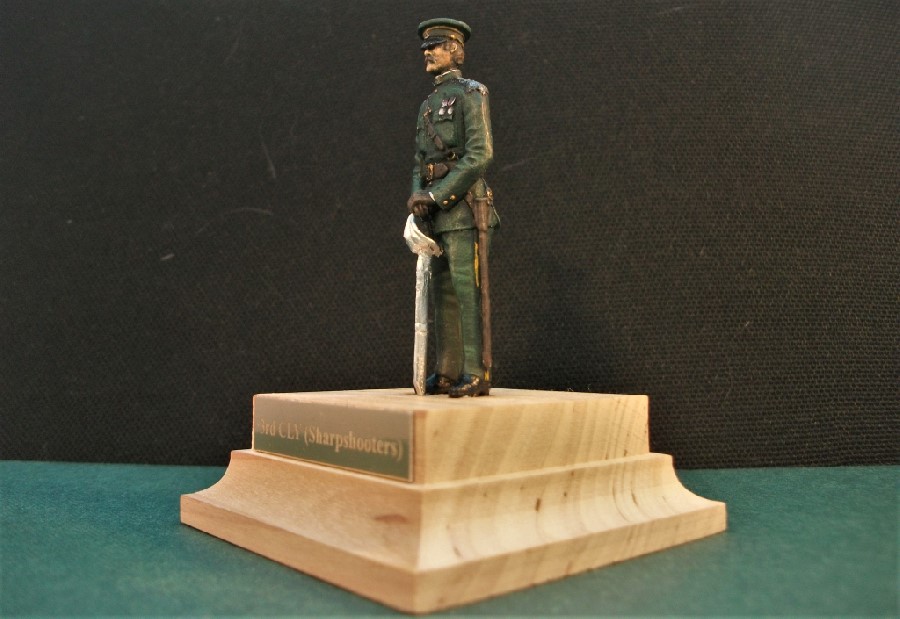
Dorset Soldiers, 3rd County of London Yeomanry (Sharpshooters), 1905.
Strelets Austro-Hungarian Infantry (1914) 
Strelets Austro-Hungarian Infantry in Gasmasks (1914)
Dorset Soldiers, Sussex Imperial Yeomanry, 1905. 
HaT Swedish Scanian Carabiniers 
HaT Swedish Horse Guards of the King
HaT Swedish Morner Hussars 
Hat Swedish Smaland Light Dragoons
Looking forward to 2019, I know well enough by now not to forecast my painting plans in any great detail as distractions lead me on to other unforeseen areas over the year! However, currently demanding my attention are:
- My Ottomania project – now well under way with the artillery corps progressing nicely;
- The Great War project – I have a number of excellent kits I intend to tackle as I continue to develop my WWI collection;
- Some 54mm Yeomanry cavalry figures are crying out for attention;
- I have my eye on a couple of soon-to-be-released new figures for 2019;
- And of course, there’s the Nappy Cavalry Project which continues proudly into its fifth year being now up to 31 regiments strong!
My ever growing pile of unpainted model soldier kits suggests the likely fate of at least some of these hobby intentions, however!
Best wishes for a happy and peaceful 2019 to all Suburban Militarism’s friends and visitors!
Marvin
Leib-Kurassiere Garde (Nappy Cavalry Project Regiment #26)

I can now just about sign off my box of Zvezda’s Saxon Cuirassiers. I say ‘just about’ because there are some holes requiring filling in. These holes appear on the horse furniture and are to attach the carbines. Sadly, I found the carbines to be a pain in the ass to fix to the figure and so abandoned all but five of them. Even then I didn’t get the pegs into the holes!

Fiddly firearms aside, the rest of the kit is very impressive and is yet another set that Zvezda can be very proud of. My only quibble might be that some of the detail is just too subtle, all of which makes bringing the detail to life so much harder! Hopefully, I’ve not done them a disservice.

You may notice all of the figures are looking to the side, something which aided the production of the figures within the mould, no doubt. I could have perhaps given the heads a twist for variety but actually I like the poses well enough.

Painting figures which are almost entirely white and black, like the Leib Cuirassiers, means limited opportunities for shading and highlighting nice, bright colours. Monochrome figures can also look pretty plain on photos as shading detail largely disappears under my budget camera lens.

Nonetheless, it’s hard not to like this regiment’s uniform which stands out nicely in contrast to other cavalry regiments in my project. The black cuirass, which was looking far too shiny in my last post, has been dulled nicely with a lick of matt varnish.


You may notice that I’ve added some purple/blue flowers (Lavender? Forget-me-nots?) to the ground across which they’re charging. There’s a nice touch of springtime about them – which is precisely what seems to be sadly absent from the UK so far this year (as I look out of the window it continues to be cold, grey and wet).
The command figures in the set are as follows:
The Officer:
He wears a more ornate cuirass (I shared a picture of a real example in my previous post) with lots of yellow braid and a black crossbelt. He also has a white plume which came separate on the sprue and required attaching on – amazingly I did this without any trouble! I realise now that I still need to paint his pistols which are attached to the horse furniture.


The Flag Bearer:
The regimental standard features a white background with white and red fringes. In the centre is a wreath of leaves surrounding a yellow and green striped shield with a green diagonal stripe underneath a crown. On the reverse is the King’s cypher.
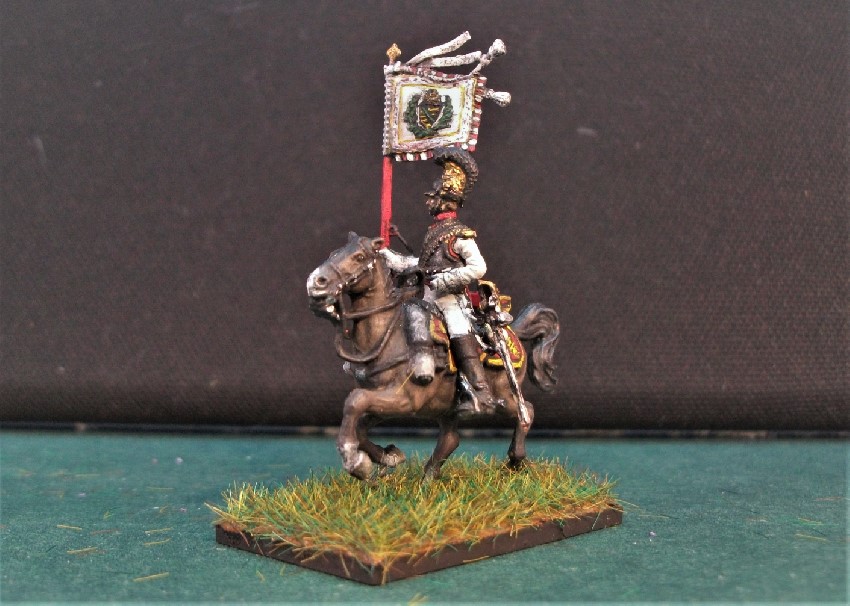

The Trumpeter:
The Leib trumpeter is mounted on a grey, as is usual for cavalry regiments, and unlike the rest of his regiment does not wear a cuirass. The helmet crest is red, as is his jacket with a white collar – in reverse colours to the regiment. The trumpet is brass and has a white/blue/yellow cord attached.


To end with, some more images and the usual regimental biography!
Biography: Leib-Kurassiere Garde [Saxony]
The regiment had its origins in 1680 as the Count von Promnitz Regiment. As such, it was one of the oldest cavalry regiments to be raised across Germany.

After combining with the Crown Prince regiment 20 years later, it was to change it’s name a number of times. In 1735, it was known as the Kürassier-Leib-Regiment with the Elector of Saxony Friedrich August II as its colonel. Respective Saxon sovereigns continued this tradition until the final dissolution of the regiment in the 20th century. In 1764, it became the Kurfürst-Kürassier-Regiment and then was known by a number of minor variations upon that name thereafter. On 23 July 1734, the Saxon cuirassiers lost their previous red coats and received a white field coat instead, a change in colour which reflected the political alignment of Saxony with Austria. This new colour was to remain with them for some time.
The regiment rode principally black, dark bays and greys. As a rule, the darker-coloured horses were placed in the front rank, while the lighter-coloured horses were posted in the second rank. The cuirassiers had armour but it was often left it in the depots during wartime.

In the course of its history, the regiment participated in many battles and campaigns. It’s first real combat came as part of a force relieving the siege of Vienna, in 1683, which was being besieged by the Turks. In 1688, it took part in the Palatinate War of Succession and then in the 1701 Spanish War of Succession. It also fought in the Silesian wars of the 1740s, notably taking part in the battles of Hohenfriedberg and Kesselsdorf. In the following Seven Years War, it was briefly forced into Prussian service resulting in large-scale desertion by its troops who refused to serve the Prussians.

By the time of the 1806 Jena Campaign , the regiment was still known as the “Kurfürst” (or prince-elector’s) regiment and fought in the great defeat at Jena. After that disastrous campaign, the “Kurfürst” became known as the Regiment König-Kürassiere, (König = king) as a consequence of Saxony being elevated to the status of a Kingdom within Napoleon’s creation of the Confederation of the Rhine.
On 24th June 1807, the Regiment König-Kürassiere changed its name once again, achieving prestigious ‘Guard’ status to be known as the Leib-Kurassiere Garde. This was a reward for its most distinguished performance for Napoleon at the battles of Heilsberg and Friedland in 1807.

Despite the losing many of its finest horses to the French army following the Jena defeat, Saxon heavy cavalry was considered excellently trained, exhibiting a professionalism long admired by other nations.

On 22 Feb 1809, the Saxon army was mobilized again and the missing horses were replaced in time for war with Austria. The regiment subsequently impressed Napoleon at Wagram where the Leib Cuirassiers drove its Austrian Cuirassier counterparts from the field, inspiring Marshal Bernadotte to say “I have always counted on you but today you have surpassed my expectations!“.

After 1810, the uniforms of the Saxon heavy cavalry changed significantly. The former Bicorne hat became a brass helmet featuring a brass comb with black woollen crest and white plume. A black fur turban wrapped around the helmet with officers wearing an additional gold oak leaf pattern overlaid. The regiment wore a black half-cuirass (only the front plates) lined red to match their facings.

The Leib-Kurassiere Garde remained at home in Dresden during the 1812 invasion of Russia, acting as a royal escort to their king. Only the Von Zastrow and Garde du Corps guard heavy cavalry went into Russia. After this terrible campaign, it was the only Saxon heavy cavalry regiment which remained intact.

The losses experienced during the war of 1812 forced the Saxon army to consolidate its heavy cavalry. In February 1813, a provisional cuirassier regiment was formed of men from the Von Zastrow and Leib-Kurassiere Garde regiments. As the 1813 Leipzig campaign developed, this regiment fought alongside the French at the battles of Bel Hautzen, Reichenbach, Dresden, Bautzen, Ostrand and Leipzig against the Prussians, Austrians and Russians.

During the Battle of the Nations (Leipzig), 4 squadrons of the provisional regiment took part in an attack where they captured a Russian battery of 12 cannons and engaged the Russian dragoons that came to its aid. French service ended with Napoleon’s defeat at Leipzig. In 1814/15, now liberated from French control, the Leib-Kürassier-Guard took part in Field Marshal Blücher’s campaign against France leading to Napoleon’s eventual abdication.
The provisional regiment, which had absorbed the Leib-Kurassiere Garde, was to eventually become known as the 1st Royal Saxon Guards Heavy Cavalry (Garde-Reiter-Regiment) until finally disbanded on 31st March 1919, after the First World War.

Notable battles: Hohenfriedberg, Jena, Heilsberg, Friedland, Wagram, Dresden, Leipzig.
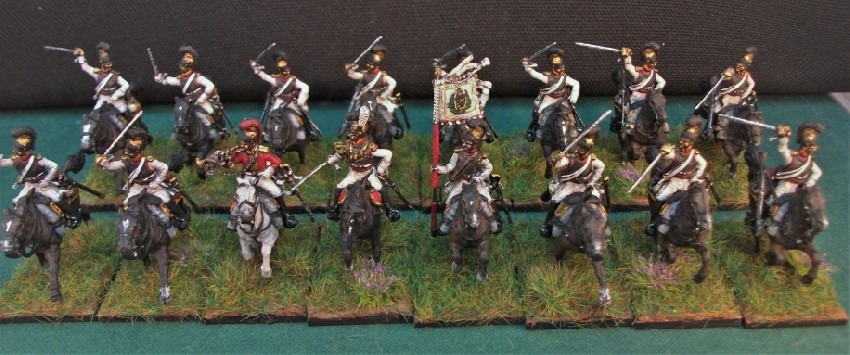
Leib and Kicking

Thanks to the woeful bank holiday weather here in the UK, I’ve had plenty of indoor time in which to progress my Saxon Leib Cuirassiers. These are now, I’m happy to say, very well advanced. The riders are about finished, less the stirrups and spurs.

The excellent, not-to-say generous, old-style Zvezda kit comes with a flag bearer, an officer and trumpeter. The officer has a white plume and a wonderfully ornate cuirass to distinguish him from the hoi-poloi of the rest of the regiment.
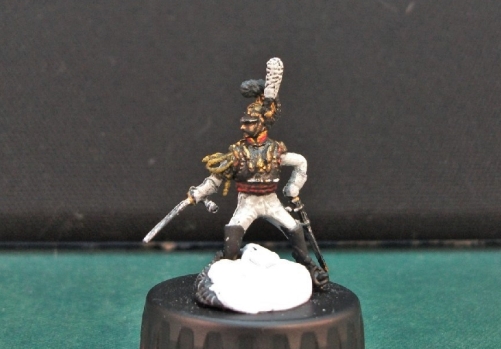
I’ve given him a black crossbelt as 1) I believe that it was worn by Saxon cuirassier officers, and 2) quite frankly I preferred it to other possibilities. The officer also has gold wreath of leaves around the front of his helmet, not really visible on this photo. His cuirass has a brass royal cypher and studs around the edge. I found an example of one on the internet:

As with the rest of the regiment, he has only a half-cuirass, the back being left unprotected to reveal his white coat.

The Trumpeter wears reverse facings (i.e. a red coat and white collar instead of the exact opposite for the rest of the regiment). He does not wear a cuirass and has a distinctive red crest on his helmet. He has brass trumpet with ornately woven cord attached.

The flag bearer has a flag which is, I believe, supposed to represent the Von Zostrow Cuirassiers. However, I understand from my research that the Leib regiment’s flag was very similar, all but identical but for colour differences and so must have looked much like my ‘attempt’ below. On one side of the flag in the centre, surrounded by a garland of leaves, is the Saxon coat of arms – a yellow and green striped shield with a green diagonal stripe under a crown:


On the other side is the royal cypher surrounded by leaves under a crown. I admit that I wasn’t sure about the crossbelt for the flag bearer and so elected for black with gold trim.

The rest of the men wear a plainer uniform with black crests, white crossbelts and the black half-cuirass. They lack the brass shoulder straps seen on the officer which I believe is simply a rare oversight by Zvezda.

The collars and turnbacks are red with yellow trim and the cuirass is lined with red.

I have to say that when I spend far, far too long than is sensible shading and highlighting all that white clothing and black crests to my satisfaction – it’s disappointing to find that virtually none of it shows up under the camera! You’ll just have to believe me when I say they look a little better to the eye…

One other thing that I’ve noticed is that under the camera my cuirasses look more of steel gunmetal colouring than black. My approach is to mix black with gunmetal paint to get the required shade. This worked well but is at the cost of losing some of the metallic shiny surface. I’ve tried to restore the metallic sheen with a little gloss varnish but I now find that it reflects the light under the lens and now looks too metallic! I may add a little thin matt black paint to reduce the reflection a tad.

Next on the painting table will be their horses. These are sturdy and well-sought-after Holstein horses – perfect for carrying their heavy cuirassier riders. Although Napoleon plundered the regiment for these Holsteins for his own cavalry in 1806-07 campaign, we can assume that they have since arranged remounts. I believe that the regiment would have had dark bay and black horses. I’ll make an exception for the trumpeter who will ride the usual grey.
Well, I’m loving being ‘back in the saddle’ painting Napoleonic cavalry, I have to admit!

Steel-plated Saxons
Taking a break from the First World War, I thought it about time to dip back into the old Nappy Cavalry Project (the last regiment in the series – the Mamelukes – being painted in July of last year). The set I’ve chosen to paint is a box I’ve had lying around for a couple of years or so but never got around to painting them. Finally, the time is right to tackle Zvezda’s Saxon Cuirassiers.

The figures are of Zvezda’s usual exceptional standard. These cuirassiers bear an uncanny resemblance to my Russian Cuirassiers of the same era which I painted over a year ago (see below example).

Both Russian and Saxon cuirassiers wore white coats with headgear of brass helmets and a black comb. Both also were protected by a black cuirass. By chance, both nation’s cuirassiers found themselves on opposite sides in the Russian campaign of 1812, including the great battle of Borodino. The Saxons, as a part of the Napoleon-sponsored “Confederation of the Rhine”, accompanied the 1812 campaign and fought alongside the French until their defeat at Leipzig in 1813.

Saxon heavy cavalry after 1800 numbered three Guard regiments, two of which – the Leib and the Von Zastrow regiments – were issued with front cuirass plates coloured black (there was no back plate worn).

So my choice is between these two; the Leib Regiment with red facings and the Von Zastrow with yellow (as illustrated above). As my previous Russian Cuirassier figures of the Astrakhan Regiment also wore yellow facings, to better differentiate I’ve chosen the Leib Curassiers as the 26th regiment in the project.

In the Nappy Cavalry Project, I like to see as much variety as possible. This latest kit is certainly the first regiment from Saxony – which is good – but visually they will look similar to Zvezda’s Russians, even with facings coloured red. One area that I can differentiate them further, however, is in the riding overalls. My Russians wear campaign grey overalls on their legs whilst the Saxons are shown in buff on the cover of the box. This was their original colour prior to 1810, but the trouble is that most contemporary illustrations I’ve found show them wearing either grey overalls again or parade-ground white breeches.

So, in keeping with the central figure shown in the wonderful old Richard Knotel illustration of the Leib Cuirassiers above, I’m opting for white breeches. I’ll simply paint over the row of buttons on the side of the legs. Not being a war-gamer, I’m happy that they look more ready for the parade ground than the battlefield. The red-jacketed trumpeter and shabraques should add a further dash of colour too.
Painting has begun already, so expect an update when they’re more progressed.

X-Men
X-Men
On the Benno’s Figures Forum website, I recently entered the monthly figure painting ‘duel’ against the mysterious Mr X. The aim is that we both paint exactly the same figure, take two photos of it, let the ‘referee’ post our pics, and then put it to members of the forum to vote for the best.

The figure we elected to tackle was one of Zvezda’s Black Hussars of Frederick the Great. Mr X didn’t have the figure in question to hand so I sent him one of mine via a go-between in Holland (to retain his anonymity).

Mr X is an undoubtedly talented artist and has deservedly won many of the duels this year. His figure was first class and as the votes came in we were virtually neck and neck until the final day of the week’s voting.
And the winner was…
…yours truly, by a mere two votes. Hurrah! A famous victory for the troops of Suburban Militarism!

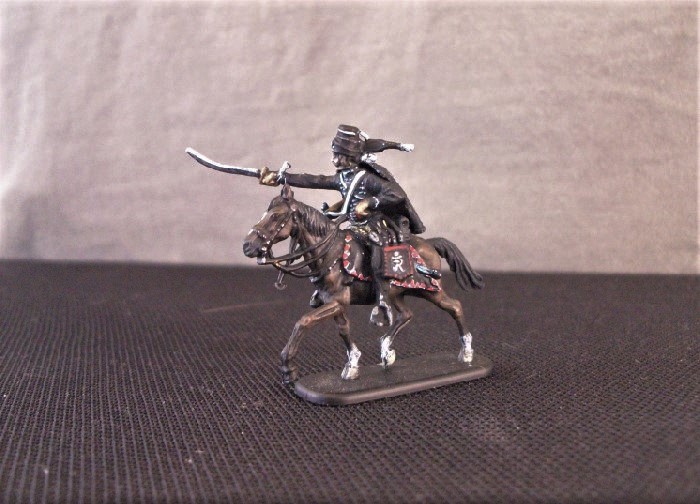
Lifeguard Dragoons (Nappy Cavalry Project Set #23)

The Russian Lifeguard Dragoons are now finished and they can join their sister regiment the Lifeguard Cossacks which I completed back in 2015. These Zvezda figures are very elegantly sculpted and beautifully proportioned. The sculpting is so subtle, however, that painting them effectively has been a real challenge. I will admit to liking a little bit more crispness in my sculpting than I’ve found in this set. But with some effort, the end result is satisfying and the Lifeguard Dragoons can proudly take its place as the 23rd regiment in the project.
Let me state – I am not a fan of pegs and holes when it comes to assembling plastic 1/72 scale figures. Maybe I’m just ham-fisted when it comes to putting these things together, but I’m not feeling confident that they would survive any careless handling. To get the riders on the horses, I found it far simpler to cut off the pegs and just rely on glue instead. After coping with some traumas, I used glue and a little modelling clay on the base of the horses to better secure them to the stands which comes with the set.
Some horses (possibly down to my assembly mistakes) look like they are in the process stumbling head first into the ground!

Another horse pose I managed to get to stay in place solely thanks to glue alone, the two pegs proving insufficient to keep it upright.

Aside from three boxes of standard troopers, I also bought a “Command” set of figures which supplied an officer, a flag bearer and a trumpeter.


I foolishly misplaced the sword, sabretache and scabbard for the flag bearer. Instead there’s a hole ready on his thigh to attach the scabbard should I a) locate it, or b) replace it with another substitute. Additionally, I should confess that I wasn’t able to source the correct flag for this regiment and so simply resorted to choosing my own design!
Much as I admire this set I’m pleased I’ve finally got this one under my belt.

With this set now completed, I’ve painted three Russian regiments in a row; the Astrakhan Cuirassiers, Sumy Hussars and now the Lifeguard Dragoons, all of which were manufactured by Zvezda. As wonderful as Zvezda’s figures are, it is perhaps time for a change of country and manufacturer?
I’m hoping to attempt a set next with some really crisp details but I’m still prevaricating over the next regiment, so expect an announcement soon. Until then; it’s time for the usual pictures and regimental biography…
Biography: Lifeguard Dragoons [Russia]

The Lifeguard Dragoons were established in 1809 from squadrons previously belonging to the Grand Duke Constantine’s Uhlans. Taking their inspiration from Napoleon’s Dragoons of the Imperial Guard, it took its place in the Tsar’s Lifeguard Cavalry Corps alongside regiments of hussars, cossacks, cuirassiers or ‘Lifeguard Horse’.
Whilst they might have lacked some of the prestige or dramatic uniforms of the Hussars or Cuirassiers, they were were undoubtedly well trained, disciplined and considered superior to other Dragoon regiments of the line.

Present at the battle of Borodino, the Lifeguard Dragoons were under Uvarov’s 1st cavalry corps, together with other Lifeguard regiments (the Lifeguard Cossacks, Lifeguard Uhlans and Lifeguard Hussars). During this 1812 campaign, they would get the chance to meet their inspiration, Napoleon’s Dragoons of the Guard. In one incident, the Lifeguard Dragoons ambushed and destroyed two squadrons of French Guard Dragoons. A force under General Ivan Dorohov, which included Cossacks and two squadrons of Lifeguard Dragoons, attacked French convoys and transports capturing 1,500 prisoners. The French countered with a small force which included 150-250 French Old Guard Dragoons which were then subsequently ambushed and destroyed at Bezovka by two squadrons of the Lifeguard Dragoons. To French General Caulaincourt, this annihilation of 150 dragoons was greeted in Napoleon’s headquarters with more dismay than “the loss of 50 generals.”

After Napoleon’s ejection from Russia, the long campaign began which would ultimately push the Napoleon all the way back to Paris. In Kulm in 1813 the Lifeguard Dragoons spearheaded the massive cavalry charge against Vandamne’s infantry. The dragoons attacked the front and ran down one regiment whilst other regiments concentrated on the enemy’s flanks. In April 1813 the dragoons were awarded with St. George standards.

In the great battle of Leipzig in 1813, the French cuirassiers routed them in the cavalry battle fought near Gulden-Gossa’s ponds. The following year, the Lifeguard Dragoons fought in the massed cavalry battle of Fère Champenoise for which they achieved the Russian military awards of 22 St. George trumpets.
Notable Battles: Borodino, Bezovka, Kulm, Leipzig, Fere Champenoise.
































